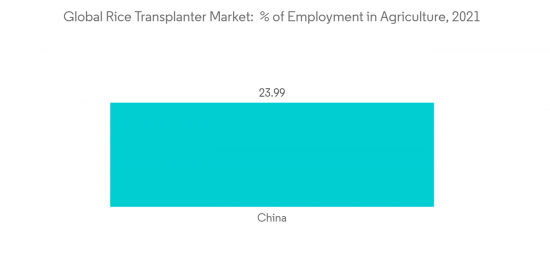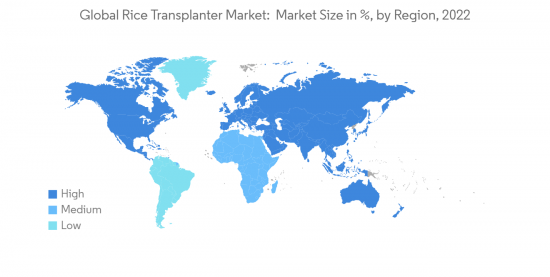 |
市場調查報告書
商品編碼
1331363
全球插秧機市場規模和份額分析——增長趨勢和預測(2023-2028)Global Rice Transplanter Market Size & Share Analysis - Growth Trends & Forecasts (2023 - 2028) |
||||||
※ 本網頁內容可能與最新版本有所差異。詳細情況請與我們聯繫。
2023年全球插秧機市場規模預計為14.8億美元,預計2028年將達到19.6億美元,在預測期內(2023-2028年)複合年增長率為5.80%,預計將增長。
主要亮點
- 由於世界人口增長,對糧食的需求不斷增加,對插秧機等農業機械的需求也在增加,特別是在亞洲等地區。 結果,農業工人正在向城市地區轉移。 全球農業勞動力減少是農民選擇插秧機等農業機械的主要原因。 根據國際勞工組織(ILO)的數據,2022年全球農業就業人口比例將下降至26%。
- 通過使用自走式插秧機,農民可以獲得比手動插秧更高的經濟效益。 與手工移植相比,機械移植顯著提高了糧食產量,並減少了勞動力和時間。 據印度糧食和農業委員會 (ICFA) 稱,到 2050 年,印度農民的比例預計將下降 25.7%。
- 亞太地區是所研究市場中最大的區域部分,佔總份額的一半以上。 稻田勞動力短缺作業的增加和持續的技術創新等驅動因素正在幫助印度和中國等主要稻米生產國提高插秧機的效率。
插秧機市場趨勢
農業工作的減少推動市場
- 在新興經濟體中,越來越多的人口依賴農業,而隨著每年越來越多的人遷移到城市地區,這一比例正在逐漸減少。 聯合國糧食及農業組織(FAO)的數據顯示,2021年中國等國家農業就業人數驟降23.9%,較上年下降24.4%。 這主要是發達國家以現代農業之名占主導地位的農業機械所致。 在貧窮國家,三分之二以上的人口從事農業,而富裕國家這一比例不到 5%。 因此,農機製造商有機會向市場推出新產品,推動未來市場增長。
- 根據國際勞工組織 (ILO) 的數據,到 2022 年,全球農業就業人口比例將下降至 26%。 在包括美國在內的許多發達國家,農民的平均年齡為60歲。 儘管如此,隨著來自農村地區的年輕人離開鄉村到城市尋找生活,平均年齡仍在上升。 這將推動新興國家機械市場在預測期內增長。
- 根據印度糧食和農業委員會的數據,到 2050 年,印度農民的比例預計將下降 25.7%,導致該國對農業機械的需求增加。 因此,預計在預測期內插秧機市場的需求將會增加。

亞太地區主導市場
- 水稻是中國和印度等許多亞洲國家的主要農作物,全球近 90% 的水稻種植於亞太地區。 亞洲國家的人口不斷增長,對糧食的需求不斷增加,尤其是像該地區人口最多的國家印度這樣的國家。
- 根據《世界人口評論》(WPR),2022 年印度人口為 141.7 億,但預計 2025 年僅達到 14.1 億。 人口的增長增加了該地區對糧食的需求。 大米是 100 多個國家的主食,擴大大米產量對於消除飢餓至關重要,特別是在亞洲。
- 印度的小農通常手工種植水稻。 手工水稻種植每公頃大約需要 238 個小時。 在評估不同水稻種植方法的性能後,發現水稻精耕方法系統的糧食產量最高,其次是機械插秧機。 由於農業所需勞動力的減少,印度機械插秧機的使用正在增加。
- 中國是世界上最大的稻米生產國,佔世界稻米產量的30%,並引進了手工、機械等多種方式。 由於缺乏熟練勞動力,農村地區的手工移植正在減少。 在這些由於人口眾多且可用勞動力比例高而土地面積較小的地區,這種情況很常見。 中國在該地區佔有很大份額,因為它向其他亞洲國家出口水稻。 中國幾乎每個省份都種植水稻,年產量佔世界水稻的四分之一以上。 印度農民更喜歡手動機械,但中國和其他亞洲國家對騎乘式插秧機的需求量很大。

插秧機行業概況
插秧機市場碎片化,各類中小企業面臨激烈競爭。 世界不同地區的區域市場和本地參與者的發展是市場碎片化的主要原因。 像久保田這樣的領先公司能夠憑藉其研發團隊和技術提供智能解決方案。 每個參與者都在以聰明和創新的方式在市場上競爭。 久保田、井關、三菱、CLASS 和凱斯紐荷蘭工業是該市場競爭的五家主要公司。
其他好處
- Excel 格式的市場預測 (ME) 表
- 3 個月的分析師支持
目錄
第一章簡介
- 研究假設和市場定義
- 調查範圍
第二章研究方法
第 3 章執行摘要
第 4 章市場動態
- 市場概覽
- 市場驅動因素
- 市場製約因素
- 波特五力分析
- 供應商的議價能力
- 買家/消費者的議價能力
- 新進入者的威脅
- 替代品的威脅
- 競爭公司之間敵對關係的強度
第五章市場細分
- 產品類型
- 駕駛式插秧機
- 步行式插秧機
- 地區
- 北美
- 美國
- 加拿大
- 墨西哥
- 其他北美地區
- 歐洲
- 德國
- 英國
- 法國
- 意大利
- 西班牙
- 俄羅斯
- 歐洲其他地區
- 亞太地區
- 中國
- 日本
- 印度
- 澳大利亞
- 其他亞太地區
- 南美洲
- 巴西
- 阿根廷
- 南美洲其他地區
- 非洲
- 南非
- 其他中東和非洲地區
- 北美
第6章競爭態勢
- 最活躍的公司
- 最常採用的策略
- 市場份額分析
- 公司簡介
- Kubota Carporation
- CNH Industrial
- CLAAS KGaA mbH
- Iseki & Co., Ltd.
- Mitsubishi
- Yanmar Co., Ltd
- Mahindra & Mahindra Limited
- TYM Corporation
- Jiangsu World Agriculture Machinery Co., Ltd
- LEMKEN GmbH & Co. KG
- Shandong Fuerwo Agricultural Equipment Co., Ltd
第7章 市場機會與今後動向
The Global Rice Transplanter Market size is estimated at USD 1.48 billion in 2023, and is expected to reach USD 1.96 billion by 2028, growing at a CAGR of 5.80% during the forecast period (2023-2028).
Key Highlights
- The rise in population across the globe is inducing a high demand for food, which in turn is driving the demand for farming machinery such as rice transplanters, especially in regions like Asia. Therefore, agricultural laborers are shifting to urban areas. The global decline in farm labor is the major reason that farm owners opt for agricultural machinery like rice transplanters. According to data from the International Labor Organization (ILO), worldwide, the percentage of people who work in agriculture dropped to 26% in 2022.
- Reducing manpower availability for agricultural work has increased mechanical transplanters' availability because using a self-propelled transplanter gives economic benefits to the farmers over manual transplanting methods. Mechanical transplanting has significantly increased grain yield and decreased drudgery and time compared to manual operations. According to the Indian Council of Food and Agriculture (ICFA), the percentage of agriculture workers in India is estimated to decline by 25.7% in 2050.
- Asia-Pacific is the largest geographical segment of the market studied and accounts for more than half of the total share. Some of the driving factors, like increasing labor shortage work in the paddy fields and continuous technological innovations, have helped increase the efficiency of rice machinery in major rice-producing countries like India and China.
Rice Transplanter Market Trends
Decline in Farm Labor is Driving the Market
- Developing economies have larger percentages of the population dependent on agriculture, decreasing over time as many people have migrated to the urban area every year. According to Food and Agriculture Organization (FAO), employment in the agriculture sector declined drastically in countries like China in 2021 by 23.9% compared to the previous year, with 24.4%. This is primarily due to agricultural machinery ruling under the name of modern agriculture in developed countries. While more than two-thirds of the population in poor countries work in agriculture, less than 5% of the population does in rich countries. This is making opportunity for the players to produce new products in the market, hence boosting the market's growth in future years.
- According to data from the International Labor Organization, worldwide, the percentage of people who work in agriculture will have dropped to 26% in 2022. In many developed countries, including the United States, the average age of a farmer is 60. Still, the average age is rising as the rural youth has branched out from their countries to seek a life in the city. This pushes the machinery market to grow in developed countries during the forecast period.
- According to the Indian Council of Food and Agriculture, the percentage of agriculture workers in India is estimated to decline by 25.7% in 2050, which has led to increasing demand for agricultural equipment in the country. Hence, the rice transplanter market demand will increase during the forecast period.

Asia-Pacific Dominates the Market
- Rice is the staple crop for many Asian countries like China and India, with almost 90% of the world's rice grown in the Asia Pacific. The growing population in Asian countries is raising the demand for food, especially in countries like India which is the most populated country in the region.
- According to the World Population Review (WPR), India's population was 141.7 cr in 2022, and it is expected to only have a population of 1.41 billion by 2025. This increase in population has increased the demand for food in the region. Rice is the main staple food in more than 100 countries, and enhancement in rice production is crucial to ending hunger, especially in Asia.
- Small farmers in India usually perform rice transplanting manually. Manual paddy transplanting required about 238 man hours per hectare. The performance of different rice establishment methods was evaluated, and the maximum grain productivity was found under the system of rice intensification method followed by mechanical transplanter. Reducing manpower availability for agricultural work has increased the availability of mechanical transplanters in India.
- China is the world's largest producer of rice, making up 30% of global rice production, which deploys various methods like manual or mechanical. Manual transplanting is declining in rural areas due to a lack of skilled labor. It is common in these areas with smaller land due to high populations and higher rates of available labor. China dominates the market in this region with a major market share as it exports paddy to other Asian countries. Nearly every province in China plants rice and produces more than one-fourth of the world's rice annually. Farmers in India prefer manually operated machines, while China and countries in Asia witness a higher demand for riding type of rice transplanter machines.

Rice Transplanter Industry Overview
The rice transplanter market is fragmented, with various small and medium-sized companies resulting in stiff competition. The development of regional markets and local players in different parts of the world is the major factor for the fragmented nature of the market. Major Player like Kubota Inc, with their R&D team and technology, is able to provide a smart solution. Every player is working smartly and in an innovative way to compete in the market. Kubota, Iseki, Mitsubishi, CLASS, and CNH Industrial are the five major players competing in the market.
Additional Benefits:
- The market estimate (ME) sheet in Excel format
- 3 months of analyst support
TABLE OF CONTENTS
1 INTRODUCTION
- 1.1 Study Assumptions and Market Definition
- 1.2 Scope of the Study
2 RESEARCH METHODOLOGY
3 EXECUTIVE SUMMARY
4 MARKET DYNAMICS
- 4.1 Market Overview
- 4.2 Market Drivers
- 4.3 Market Restraints
- 4.4 Porter's Five Forces Analysis
- 4.4.1 Bargaining Power of Suppliers
- 4.4.2 Bargaining Power of Buyers/Consumers
- 4.4.3 Threat of New Entrants
- 4.4.4 Threat of Substitute Products
- 4.4.5 Intensity of Competitive Rivalry
5 MARKET SEGMENTATION
- 5.1 Product Type
- 5.1.1 Ride-on Rice Transplanter
- 5.1.2 Walking Rice Transplanter
- 5.2 Geography
- 5.2.1 North America
- 5.2.1.1 United States
- 5.2.1.2 Canada
- 5.2.1.3 Mexico
- 5.2.1.4 Rest of North America
- 5.2.2 Europe
- 5.2.2.1 Germany
- 5.2.2.2 United Kingdom
- 5.2.2.3 France
- 5.2.2.4 Italy
- 5.2.2.5 Spain
- 5.2.2.6 Russia
- 5.2.2.7 Rest of Europe
- 5.2.3 Asia Pacific
- 5.2.3.1 China
- 5.2.3.2 Japan
- 5.2.3.3 India
- 5.2.3.4 Australia
- 5.2.3.5 Rest of Asia-Pacific
- 5.2.4 South America
- 5.2.4.1 Brazil
- 5.2.4.2 Argentina
- 5.2.4.3 Rest of South America
- 5.2.5 Africa
- 5.2.5.1 South Africa
- 5.2.5.2 Rest of Middle East & Africa
- 5.2.1 North America
6 COMPETITIVE LANDSCAPE
- 6.1 Most Active Companies
- 6.2 Most Adopted Strategies
- 6.3 Market Share Analysis
- 6.4 Company Profiles
- 6.4.1 Kubota Carporation
- 6.4.2 CNH Industrial
- 6.4.3 CLAAS KGaA mbH
- 6.4.4 Iseki & Co., Ltd.
- 6.4.5 Mitsubishi
- 6.4.6 Yanmar Co., Ltd
- 6.4.7 Mahindra & Mahindra Limited
- 6.4.8 TYM Corporation
- 6.4.9 Jiangsu World Agriculture Machinery Co., Ltd
- 6.4.10 LEMKEN GmbH & Co. KG
- 6.4.11 Shandong Fuerwo Agricultural Equipment Co., Ltd













